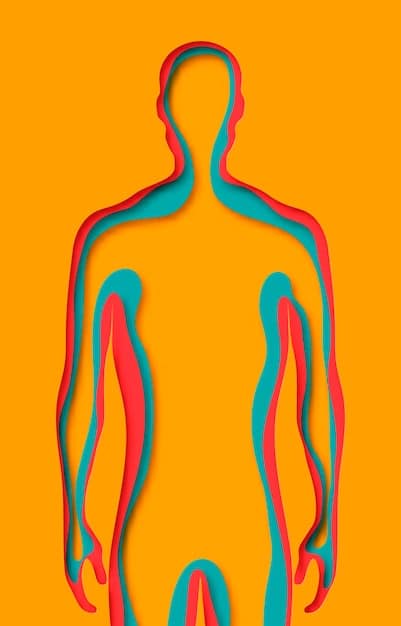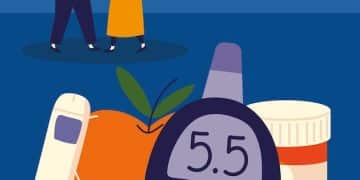Testosterone Levels and Men’s Sexual Health: What You Must Know

Navigating the complexities of male sexual health often leads to questions about testosterone levels, a pivotal hormone directly influencing libido, erectile function, and overall well-being, crucial for comprehensive understanding and effective management.
Understanding the interplay between testosterone levels and sexual health: what every man needs to know is more than a medical inquiry; it’s a journey into the core of male vitality. This essential hormone shapes not only physical attributes but also deeply impacts libido, energy, and mood. For many men, recognizing the signs and symptoms associated with testosterone imbalances is the first step towards proactive health management and reclaiming a robust quality of life.
The Crucial Role of Testosterone in Male Physiology
Testosterone, often hailed as the primary male sex hormone, is far more than just a driver of libido or muscle growth. Produced primarily in the testes, this androgen plays a multifaceted role in the male body, influencing a vast array of physiological processes from conception through adulthood. Its significance extends to the development of male reproductive tissues, the regulation of bone density, red blood cell production, and even cognitive functions.
The impact of testosterone is profound, beginning in utero where it guides the formation of male characteristics. During puberty, it orchestrates dramatic changes, including voice deepening, hair growth, and increased muscle mass and bone strength. Throughout adulthood, stable testosterone levels are critical for maintaining these characteristics, ensuring not only physical vitality but also mental well-being and sexual function.
Beyond Sexual Function: Broader Health Implications
While commonly associated with sexual health, testosterone’s influence permeates nearly every system of the male body. Its role in maintaining energy levels, reducing fatigue, and supporting mood stability often goes unnoticed until levels begin to decline. This hormone acts as a key regulator, ensuring metabolic efficiency and even influencing cardiovascular health.
- Bone Density: Adequate testosterone is vital for strong bones, helping prevent osteoporosis.
- Red Blood Cell Production: It stimulates the bone marrow to produce red blood cells, impacting overall energy and oxygen transport.
- Cognitive Function: Research suggests a link between testosterone and memory, spatial abilities, and mood regulation.
- Metabolic Health: It plays a role in fat distribution and insulin sensitivity, helping to prevent metabolic syndrome.
The decline in testosterone, a natural part of aging, can manifest in subtle but significant ways, often affecting quality of life long before serious health issues arise. Understanding its comprehensive role allows men to identify potential issues early and seek appropriate medical advice, transforming awareness into proactive health management. Early recognition of symptoms associated with dipping testosterone levels can pave the way for timely interventions, improving health outcomes and restoring a sense of well-being.
Recognizing Symptoms of Low Testosterone (Low T)
Identifying the symptoms of low testosterone, or hypogonadism, can be challenging due to their often subtle and varied nature. Many men dismiss these changes as normal aging or stress-related issues, delaying crucial diagnosis and treatment. However, recognizing these indicators is the first step toward understanding and addressing a potential testosterone imbalance. Low T can manifest through a spectrum of physical, emotional, and sexual changes, each capable of significantly impacting a man’s quality of life.
Physical and Emotional Manifestations
Beyond the well-known sexual health implications, low testosterone frequently presents with a range of non-sexual symptoms that affect overall physical and mental well-being. These can include changes in body composition, energy levels, and even sleep patterns. The insidious onset of these symptoms often means they are attributed to other conditions, making accurate diagnosis critical.
- Fatigue and Reduced Energy: Persistent tiredness, even after adequate sleep, is a common complaint.
- Increased Body Fat and Decreased Muscle Mass: Despite consistent exercise, men may notice an increase in abdominal fat and a loss of lean muscle.
- Decreased Bone Density: Bones may become weaker and more brittle, increasing the risk of fractures.
- Mood Changes: Irritability, depression, and generalized sadness or a lack of motivation are frequently reported.
- Sleep Disturbances: Insomnia or other sleep pattern disruptions can be a symptom, further exacerbating fatigue.
These generalized symptoms underscore the comprehensive impact of testosterone on the body’s systems. A holistic approach to evaluating a man’s health is essential when considering a potential diagnosis of low T. It’s imperative not to self-diagnose based on symptoms alone, as many of these can overlap with other medical conditions.
Sexual Health Indicators of Low T
For many men, the most direct and alarming symptoms of low testosterone relate to sexual function. These issues, while sometimes difficult to discuss, serve as clear signals that hormonal balance may be compromised. Addressing these concerns openly with a healthcare provider is paramount for proper evaluation and management.
- Reduced Libido: A noticeable decrease in sex drive, often extending to a general lack of interest in sexual activity.
- Erectile Dysfunction (ED): Difficulty achieving or maintaining an erection firm enough for sexual intercourse.
- Fewer Spontaneous Erections: A decrease in nocturnal or morning erections.
- Reduced Semen Volume: Testosterone contributes to semen production, and lower levels can lead to a noticeable decrease in ejaculate.
These sexual health symptoms can have a significant psychological impact, affecting self-esteem, relationships, and overall life satisfaction. It is crucial to remember that these are not inevitable consequences of aging and often can be managed effectively with appropriate medical intervention. Engaging in open dialogue with healthcare professionals can lead to significant improvements in both sexual function and overall quality of life.

Unpacking the Causes of Low Testosterone
The causes of low testosterone are diverse, ranging from natural aging processes to underlying medical conditions and lifestyle factors. Understanding these causes is fundamental to both prevention and effective treatment. While a gradual decline in testosterone with age is normal, significant drops or early onset low T often point to specific biological or environmental influences that warrant investigation.
Identifying the root cause is crucial for developing a personalized treatment plan that addresses the specific needs of each individual. This journey often requires a thorough medical evaluation, moving beyond simple symptom recognition to uncover the precise factors contributing to hormonal imbalance. The intricate dance of hormones within the body means that what appears to be a singular issue can often be influenced by a multitude of factors.
Age, Lifestyle, and Medical Conditions
Age is undeniably the most common factor in declining testosterone levels, with men experiencing a gradual decrease starting around age 30 and continuing throughout life. However, age is not the sole determinant, and a confluence of lifestyle choices and pre-existing medical conditions can significantly accelerate this decline or cause low T in younger men.
- Natural Aging Process (Andropause): As men age, the testes naturally produce less testosterone.
- Obesity: Excess body fat, particularly abdominal fat, can convert testosterone into estrogen, further reducing active testosterone.
- Chronic Diseases: Conditions such as type 2 diabetes, kidney disease, liver disease, and HIV/AIDS are frequently associated with lower testosterone.
- Medications: Certain prescription drugs, including opioids and glucocorticoids, can suppress testosterone production.
- Stress: Chronic stress elevates cortisol levels, which can negatively impact testosterone synthesis.
- Poor Nutrition and Lack of Exercise: Unhealthy diets and sedentary lifestyles contribute to overall poor health, including hormonal imbalances.
These factors often interact in complex ways, creating a challenging scenario for diagnosis and treatment. For example, obesity exacerbates the decline seen with aging, and chronic disease can further complicate an already declining hormonal profile. A comprehensive approach considering all these aspects is therefore essential for effective management.
Primary vs. Secondary Hypogonadism
Medically, low testosterone is classified into two main types based on the origin of the dysfunction: primary and secondary hypogonadism. Understanding this distinction is vital as it dictates the diagnostic approach and treatment strategy. Each type points to a different location in the body’s hormonal axis as the source of the problem.
Primary hypogonadism originates in the testes themselves, meaning the testes are not producing enough testosterone despite adequate stimulation from the brain. Causes include:
- Testicular injury or trauma
- Genetic conditions like Klinefelter syndrome
- Mumps orchitis (inflammation of the testicle due to mumps)
- Chemotherapy or radiation treatment
- Testicular cancer
Secondary hypogonadism occurs when the defect lies in the pituitary gland or hypothalamus in the brain, which fail to send the necessary signals (Luteinizing Hormone – LH, and Follicle-Stimulating Hormone – FSH) to the testes to produce testosterone. Causes include:
- Pituitary tumors
- Kallmann syndrome (a genetic condition affecting hormone-producing cells)
- Certain medications or chronic opioid use
- Excessive exercise or extreme weight loss
- Chronic stress or psychological conditions
Distinguishing between these two types often involves blood tests for testosterone, LH, and FSH. This detailed assessment helps healthcare providers pinpoint the exact cause and tailor the most appropriate therapeutic intervention, emphasizing the importance of an accurate diagnosis for optimal outcomes.
Diagnosing Low Testosterone: The Medical Approach
Diagnosing low testosterone involves more than just recognizing symptoms; it requires a precise medical evaluation that typically begins with blood tests. Because testosterone levels fluctuate throughout the day, accurate measurement often necessitates specific timing and repeat testing to confirm a diagnosis. This careful approach ensures that a true deficiency is identified, rather than temporary variations or misinterpretations of symptoms. A proper diagnosis is the cornerstone of effective management, guiding treatment decisions and avoiding unnecessary interventions.
The diagnostic process is a collaborative effort between the patient and healthcare provider, combining a thorough medical history, physical examination, and laboratory tests. This comprehensive assessment allows for a nuanced understanding of the patient’s overall health and the potential contributing factors to their symptoms. It’s not just about one number, but about the whole clinical picture.
Blood Tests and Timing
The most reliable method for diagnosing low testosterone is a blood test measuring total testosterone levels. Due to natural diurnal variations, where testosterone levels are highest in the morning, tests are typically recommended to be drawn early in the day. This standardization helps minimize variability and provides a more consistent baseline for evaluation.
A single low reading is often not sufficient for a definitive diagnosis. Physicians usually recommend:
- Morning Blood Draw: Samples are ideally taken between 7:00 AM and 10:00 AM, when testosterone levels are typically at their peak.
- Repeat Testing: If the initial reading is low, a second confirmed low reading on a separate day is usually required to establish a diagnosis of hypogonadism.
- Additional Hormones: Tests for Luteinizing Hormone (LH) and Follicle-Stimulating Hormone (FSH) help differentiate between primary and secondary hypogonadism, indicating whether the problem originates in the testes or the brain.
- Sex Hormone Binding Globulin (SHBG): Measuring SHBG, a protein that binds to testosterone, helps determine the amount of “free” or bioavailable testosterone, which is the active form of the hormone.
These detailed tests provide a comprehensive hormonal profile, essential for pinpointing the exact nature of the deficiency. The interpretation of these results requires expertise, as normal ranges can vary, and individual patient symptoms must also be considered.
Comprehensive Clinical Evaluation
Beyond blood tests, a thorough clinical evaluation is paramount for diagnosing low testosterone. This includes a detailed medical history and a physical examination to identify potential underlying causes or contributing factors. The symptoms of low T can mimic those of other conditions, making a differential diagnosis crucial.
The clinical evaluation involves:
- Medical History: Discussing symptoms, their duration, severity, and impact on daily life. Information about chronic diseases (e.g., diabetes, hypertension), medications, past surgeries, and family history is also collected.
- Physical Examination: Assessing body hair distribution, muscle mass, fat distribution, and testicular size. Checking for signs of other hormonal imbalances or related conditions.
- Lifestyle Assessment: Inquiring about diet, exercise habits, sleep patterns, alcohol consumption, smoking, and stress levels, all of which can influence testosterone.
- Symptom Correlation: Evaluating how well the patient’s symptoms align with the laboratory findings, ensuring that treatment is based on clinical need, not just numerical values.
This holistic approach ensures that low testosterone is accurately diagnosed and that any concurrent health issues are also identified and addressed. A precise diagnosis paves the way for effective treatment strategies, whether through lifestyle modification, hormonal therapy, or addressing underlying medical conditions.
Treatment Options for Low Testosterone (TRT and Beyond)
Once low testosterone is diagnosed, several treatment options are available, ranging from lifestyle modifications to hormone replacement therapy. The choice of treatment depends on the underlying cause of the deficiency, the severity of symptoms, and the patient’s overall health status and preferences. A personalized approach, guided by a healthcare professional, is essential to ensure efficacy and minimize potential risks. The goal of treatment is not just to normalize testosterone levels but also to alleviate symptoms and improve overall quality of life, balancing benefits against any potential adverse effects.
Navigating the various treatment pathways can be complex, requiring careful consideration of each option’s pros and cons. It’s an ongoing dialogue between patient and physician, adjusting strategies as needed based on response and evolving health conditions. Informed decision-making is key to successful management.
Testosterone Replacement Therapy (TRT)
Testosterone Replacement Therapy (TRT) is the most direct method for restoring testosterone levels in men with clinically diagnosed hypogonadism. TRT involves administering exogenous testosterone to the body, either to supplement or entirely replace the body’s natural production. Various forms of TRT are available, each with its own administration method, frequency, and absorption characteristics, offering flexibility in treatment choice.
- Injections: Typically administered intramuscularly, either weekly or bi-weekly. This is often the most cost-effective and provides stable levels.
- Gels/Topical Solutions: Applied daily to the skin, allowing for gradual absorption. Convenient but requires caution to prevent transference to others.
- Patches: Applied to the skin daily, releasing testosterone slowly over time.
- Pellets: Small pellets are surgically implanted under the skin, releasing testosterone consistently for several months.
- Nasal Gels: Applied into the nasal passages, offering another discreet daily option.
While TRT can significantly improve symptoms like fatigue, low libido, and muscle loss, it is not without potential side effects. These can include increased red blood cell count (polycythemia), sleep apnea exacerbation, and skin reactions at the application site. Long-term effects on cardiovascular health and prostate health are subjects of ongoing research and require careful monitoring. Therefore, TRT should always be managed by a qualified healthcare professional, with regular blood tests and follow-up appointments to monitor levels and assess overall patient well-being.
Lifestyle Modifications and Holistic Approaches
For some men, particularly those with borderline low testosterone or age-related decline, lifestyle modifications can play a significant role in naturally boosting testosterone levels and improving overall health. These approaches focus on optimizing the body’s natural processes and reducing factors that contribute to testosterone suppression. The emphasis is on sustainable changes that benefit multiple aspects of health.
- Regular Exercise: Especially strength training and high-intensity interval training (HIIT), can naturally raise testosterone levels.
- Healthy Diet: A balanced diet rich in whole foods, healthy fats, and adequate protein supports overall hormonal health. Avoid processed foods and excessive sugar.
- Weight Management: Reducing excess body fat, particularly abdominal obesity, can help improve testosterone levels by reducing its conversion to estrogen.
- Adequate Sleep: Chronic sleep deprivation can significantly lower testosterone. Aim for 7-9 hours of quality sleep per night.
- Stress Reduction: Chronic stress elevates cortisol, which can suppress testosterone. Practicing mindfulness, meditation, or engaging in hobbies can help.
- Avoidance of Endocrine Disruptors: Limiting exposure to certain chemicals (e.g., BPA in plastics, phthalates) that can interfere with hormone production.
These lifestyle changes offer a holistic strategy for supporting testosterone production and enhancing general well-being. While they may not be sufficient for men with severe hypogonadism, they are invaluable as complementary strategies to TRT or as primary interventions for mild cases. Combining medical treatments with healthy lifestyle choices often yields the most comprehensive and sustainable improvements in health outcomes. The long-term benefits of these foundational health habits extend far beyond testosterone, contributing to overall longevity and disease prevention.
Testosterone and Erectile Dysfunction (ED): A Complex Relationship
The relationship between testosterone and erectile dysfunction (ED) is often discussed but frequently misunderstood. While low testosterone can contribute to ED, it is rarely the sole cause, and ED can result from a multitude of factors, including cardiovascular disease, diabetes, neurological conditions, and psychological issues. Understanding this complex interplay is crucial for accurate diagnosis and effective treatment. Simply boosting testosterone may not resolve ED if other underlying issues are present; a comprehensive assessment is always necessary to pinpoint the primary drivers of erectile difficulties.
The precise role of testosterone in erectile function extends beyond simply influencing libido, also impacting cavernous smooth muscle function and neuronal pathways. Thus, while a common symptom of low T, ED demands a broader diagnostic lens.
When Low T Contributes to ED
There are instances where low testosterone directly contributes to or exacerbates erectile dysfunction. Testosterone plays a role in the neurological processes that initiate an erection and helps maintain the health of the penile tissues, including the smooth muscle cells in the corpora cavernosa. When levels are significantly low, men may experience:
- Reduced Libido: A primary way low T impacts ED is by decreasing sexual interest, which is a prerequisite for desire-driven erections.
- Impaired Nitric Oxide Synthesis: Testosterone influences the ability of blood vessels to produce nitric oxide, a key molecule for vasodilation and blood flow into the penis necessary for an erection.
- Changes in Penile Tissue Health: Chronic low testosterone can lead to structural changes in the penis, such as thinning of the smooth muscle and reduced elasticity, making erections more difficult to achieve and sustain.
In these cases, where ED is clearly linked to demonstrably low testosterone, TRT can be an effective treatment. However, it’s essential to note that the response to TRT for ED varies significantly among individuals. Some men experience marked improvement, while others may see little change, particularly if other strong contributing factors to their ED exist. Therefore, managing expectations and identifying all potential causes is vital.
Beyond Testosterone: Other Causes of ED
It is critical for men experiencing ED to understand that while testosterone levels are a piece of the puzzle, they are seldom the only piece. Many common health conditions and lifestyle factors can lead to or worsen ED, often independently of testosterone levels. A focus solely on testosterone without considering these other elements can lead to ineffective treatment and delayed diagnosis of more serious underlying health problems.
- Cardiovascular Disease: Atherosclerosis (hardening of the arteries) can restrict blood flow to the penis, a very common cause of ED.
- Diabetes: High blood sugar can damage nerves and blood vessels, leading to ED.
- Neurological Conditions: Diseases like Parkinson’s, multiple sclerosis, or stroke can interfere with nerve signals necessary for erections.
- Psychological Factors: Stress, anxiety, depression, relationship problems, and performance anxiety can all significantly contribute to ED.
- Medications: Antidepressants, antihypertensives, and certain prostate medications can have ED as a side effect.
- Lifestyle Factors: Smoking, excessive alcohol consumption, obesity, and lack of physical activity are significant contributors to ED.
Given the multifactorial nature of ED, a comprehensive medical evaluation is always recommended. This assessment allows healthcare providers to identify all contributing factors and formulate a tailored treatment plan, which may include testosterone therapy, lifestyle changes, medications (like PDE5 inhibitors), or psychological counseling, thus addressing the problem from all angles for the best possible outcome. Often, addressing the primary underlying health issue will simultaneously improve erectile function, even if testosterone levels are within a normal range.
Maintaining Optimal Testosterone Levels for Lifelong Health
Proactively maintaining optimal testosterone levels is not solely about addressing a deficiency but also about fostering lifelong health and vitality. While aging inevitably brings changes, strategic lifestyle choices and informed medical monitoring can significantly support hormonal balance, contributing to improved quality of life, energy, and overall well-being. This proactive stance transcends mere treatment of symptoms, advocating for a preventive and holistic approach to male health.
The concept of “optimal” testosterone levels can vary by individual, but the principles of maintaining them are quite universal, focusing on foundational health habits. It’s about empowering men to take control of their physiological health through daily habits and regular medical check-ups.
Preventative Measures and Healthy Habits
For men of all ages, adopting and consistently adhering to a set of healthy habits is the most effective preventative measure against significant drops in testosterone and related health issues. These habits contribute to overall endocrine health, supporting the body’s natural hormone production and regulation. Consistency is crucial, as the benefits accumulate over time, building a resilient physiological foundation.
- Balanced Nutrition: Emphasize whole, unprocessed foods. Incorporate healthy fats (avocados, nuts, olive oil), lean proteins, and complex carbohydrates. Ensure adequate intake of zinc and vitamin D, both crucial for testosterone production.
- Regular Physical Activity: Engage in a mix of resistance training (weightlifting) and cardiovascular exercise. Muscle mass is positively correlated with testosterone, and exercise helps manage weight, reducing aromatization of testosterone to estrogen.
- Adequate Sleep: Prioritize 7-9 hours of quality sleep nightly. Testosterone production largely occurs during deep sleep cycles. Sleep deprivation significantly impacts hormone regulation.
- Stress Management: Chronic stress elevates cortisol, which has a suppressive effect on testosterone. Practices like meditation, yoga, hobbies, and spending time in nature can help mitigate stress.
- Maintain a Healthy Weight: Excess body fat, particularly visceral fat, is pro-inflammatory and contributes to lower testosterone levels. Weight loss, even moderate, can significantly improve testosterone.
These lifestyle pillars form the basis of not only maintaining adequate testosterone but also protecting against a myriad of chronic diseases. They are intertwined, with improvements in one area often positively impacting others, creating a virtuous cycle of health. Starting these habits early in life can lay a strong foundation for hormonal health in later decades.
Regular Monitoring and Professional Guidance
Beyond lifestyle, regular medical monitoring provides invaluable insight into hormonal status and overall health. For men, especially as they age, periodic check-ups allow for early detection of declining testosterone levels or other health issues that may impact hormonal balance. Professional guidance ensures that any interventions are appropriate, safe, and tailored to individual needs, preventing misdiagnosis or inappropriate treatment.
Key aspects of professional guidance and monitoring include:
- Routine Blood Work: Regular check-ups should include total testosterone levels, especially if symptoms of low T are present or as part of a comprehensive preventative health panel.
- Discussion of Symptoms: Openly communicate any changes in energy, mood, libido, or physical changes with your doctor. These discussions help piece together the clinical picture.
- Addressing Underlying Health Conditions: Actively manage chronic diseases like diabetes, hypertension, and sleep apnea, as these can significantly influence testosterone levels.
- Medication Review: Periodically review all medications with your doctor, as some can impact hormone levels.
- Individualized Treatment Plans: If TRT is considered, work closely with an experienced physician to discuss the various forms of therapy, potential benefits, risks, and monitoring requirements.
- Holistic Health Strategy: Collaborate with your healthcare provider to develop a holistic health strategy that integrates lifestyle, nutrition, and medical interventions, rather than focusing on isolated symptoms.
By combining proactive healthy living with informed medical oversight, men can optimize their testosterone levels and, resultantly, their overall health and vitality throughout their lives. This integrated approach fosters not just longevity, but also a sustained high quality of life, emphasizing that maintaining hormonal balance is a continuous, active process, rather than a passive event. It’s about taking charge of your health destiny with knowledge and partnership.
| Key Point | Brief Description |
|---|---|
| 💪 Testosterone’s Broad Role | Crucial for libido, energy, mood, bone density, and muscle mass, beyond just sexual health. |
| 🧐 Low T Symptoms | Includes fatigue, increased body fat, mood swings, reduced libido, and erectile dysfunction. |
| 🩺 Diagnosis & Treatment | Requires blood tests & clinical evaluation; options range from lifestyle a TRT (Testosterone Replacement Therapy). |
| 🤸♂️ Lifelong Optimization | Healthy habits, regular exercise, balanced diet, and stress management are key to maintaining optimal levels. |
Frequently Asked Questions About Testosterone and Male Health
Normal total testosterone levels for adult men typically range from 300 to 1,000 nanograms per deciliter (ng/dL). However, “normal” can vary based on age, laboratory, and individual health. Symptomatic low levels below this range usually indicate hypogonadism, requiring medical evaluation and potentially treatment to alleviate associated issues.
While often associated with high testosterone due to its conversion to DHT, very low testosterone can indirectly contribute to hair thinning or loss in some men. Testosterone is crucial for overall health, and imbalances can impact various body systems, including hair follicle health. However, genetic factors are typically the primary cause of male pattern baldness.
Yes, several natural strategies can help optimize testosterone. These include regular strength training and high-intensity interval training, maintaining a healthy weight, ensuring adequate sleep (7-9 hours), consuming a balanced diet rich in healthy fats and zinc, and managing chronic stress. These lifestyle changes support overall hormonal balance effectively.
The link between TRT and prostate cancer has been a subject of extensive research. Current evidence does not support the idea that TRT increases the risk of developing prostate cancer in men without pre-existing cancer. However, TRT may accelerate the growth of existing, undiagnosed prostate cancer, necessitating careful screening and monitoring for men on therapy.
The timeline for results from TRT varies, but improvements are generally gradual. Energy levels may improve within weeks, while mood changes and libido may take a month or more. Effects on muscle mass, fat reduction, and bone density are typically noticed over several months of consistent therapy. Full benefits often manifest after 3-6 months.

Conclusion: Empowering Men Through Hormonal Understanding
The intricate relationship between testosterone levels and a man’s sexual health, alongside his overall well-being, is a domain ripe for empowered understanding. Moving beyond simplistic views, this exploration emphasizes that managing testosterone is a crucial aspect of men’s health, impacting everything from physical vitality and cognitive function to emotional stability and sexual health. By recognizing the subtle and overt symptoms of imbalance, seeking precise diagnosis, and embracing a tailored combination of medical and lifestyle interventions, men can proactively navigate the complexities of their hormonal landscape. This journey of awareness and action promises not just relief from symptoms, but a profound recalibration towards improved quality of life and sustained vitality throughout their years. Taking charge of hormonal health is taking charge of life, ensuring a more vibrant and fulfilling future.





